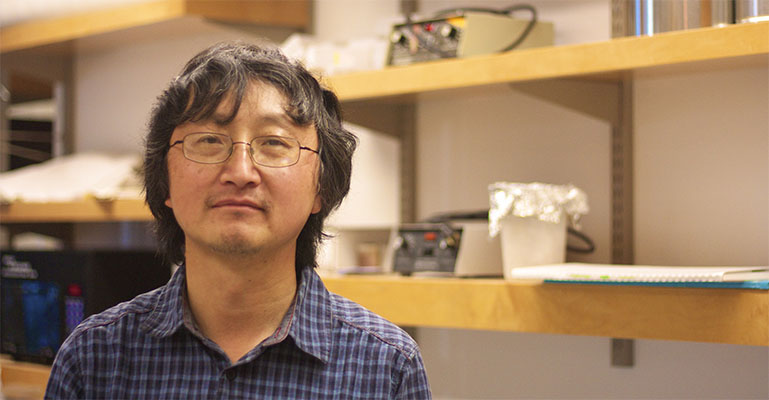The Faculty

Tao Pan
Professor, Department of Biochemistry and Molecular Biology
Affiliation: Biochemistry & Molecular Biology, Institute for Biophysical Dynamics, Institute for Genomics & Systems Biology, Committee on Microbiology
Focus
RNA genomics, RNA folding
Education
Ph.D., Yale University, 1990
Diplom, University des Saarlandes, 1986
Awards and accolades
1991 - 1993 Damon Runyon-Walter Winchell Cancer Research Fund
1994 - Cancer Research Foundation, Raymond F. Zelko Young Investigator
1995 - 1997 American Cancer Society, Junior Faculty Research Award
2009 - 2013 NIH EUREKA award
2011 - 2016 NIH Director’s Pioneer award
2015 - American Association for the Advancement of Science (AAAS) Fellow
Research Summary
Translational regulation is related to the dynamic properties of tRNA that constantly change to facilitate stress response and adaptation to new environments and to control gene expression. We developed microarray methods that measure tRNA abundance, fraction of aminoacylation and misacylation at the genomic scale. We are exploring roles of tRNA in translational control in mammalian cells.
A central tenet of biology is the accurate flow of information from nucleic acids to proteins through the genetic code. It is commonly believed that translation deviating from the genetic code is avoided at all times. We discovered that mammalian cells can deliberately reprogram the genetic code through tRNA misacylation upon innate immune activation and chemically triggered oxidative stress. The reprogramming is regulated by fluctuating levels of reactive oxygen species (ROS) in the cell. We are investigating how regulated mis-translation is used as a mechanism for stress response.
Over 100 types of post-transcriptional RNA modifications have been identified in thousands of sites from bacteria to humans. They include methylation of bases and the ribose backbone, rotation and reduction of uridine, base deamination, addition of ring structures and carbohydrate moieties, and so on. RNA modifications are involved in stress response, environmental adaptation, and antibiotic resistance. Some modifications can be removed by cellular enzymes, leading to dynamic regulation of their function. We are developing genome-wide methods and applying these to study the function of RNA modifications in cell growth, adaptation and development.
Non-coding RNAs perform biological function without being translated into proteins. Some estimates suggest that in human, the number of non-coding RNAs may be comparable to the number of coding RNAs. We are investigating how RNA folds during transcription to understand RNA folding in the cell.
Gene regulation/expression
Systems Biology
Selected Papers
Zhang W, Pan T. Pseudouridine RNA modification detection and quantification by RT-PCR. Methods. 2021 May 18.
Huang J, Chen W, Zhou F, Pang Z, Wang L, Pan T, Wang X. Tissue-specific reprogramming of host tRNA transcriptome by the microbiome. Genome Res. 2021 Jun; 31(6):947-957.
Sun L, Wei N, Kuhle B, Blocquel D, Novick S, Matuszek Z, Zhou H, He W, Zhang J, Weber T, Horvath R, Latour P, Pan T, Schimmel P, Griffin PR, Yang XL. CMT2N-causing aminoacylation domain mutants enable Nrp1 interaction with AlaRS. Proc Natl Acad Sci U S A. 2021 Mar 30; 118(13).
Matuszek Z, Pan T. Quantification of Queuosine Modification Levels in tRNA from Human Cells Using APB Gel and Northern Blot. Bio Protoc. 2019 Mar 20; 9(6):e3191.
Wang Y, Katanski CD, Watkins C, Pan JN, Dai Q, Jiang Z, Pan T. A high-throughput screening method for evolving a demethylase enzyme with improved and new functionalities. Nucleic Acids Res. 2021 03 18; 49(5):e30.
Chen M, Kuhle B, Diedrich J, Liu Z, Moresco JJ, Yates Iii JR, Pan T, Yang XL. Cross-editing by a tRNA synthetase allows vertebrates to abundantly express mischargeable tRNA without causing mistranslation. Nucleic Acids Res. 2020 07 09; 48(12):6445-6457.
Zhang W, Xu R, Matuszek Z, Cai Z, Pan T. Detection and quantification of glycosylated queuosine modified tRNAs by acid denaturing and APB gels. RNA. 2020 09; 26(9):1291-1298.
Eckwahl M, Xu R, Michalkiewicz J, Zhang W, Patel P, Cai Z, Pan T. 5-Methylcytosine RNA Modifications Promote Retrovirus Replication in an ALYREF Reader Protein-Dependent Manner. J Virol. 2020 06 16; 94(13).
Zhang J, Lu R, Zhang Y, Matuszek Z, Zhang W, Xia Y, Pan T, Sun J. tRNA Queuosine Modification Enzyme Modulates the Growth and Microbiome Recruitment to Breast Tumors. Cancers (Basel). 2020 Mar 09; 12(3).
Jurczyszak D, Zhang W, Terry SN, Kehrer T, Bermúdez González MC, McGregor E, Mulder LCF, Eckwahl MJ, Pan T, Simon V. HIV protease cleaves the antiviral m6A reader protein YTHDF3 in the viral particle. PLoS Pathog. 2020 02; 16(2):e1008305.
Zhang W, Pan T. A dual function PUS enzyme. Nat Chem Biol. 2020 02; 16(2):107-108.
Blocquel D, Sun L, Matuszek Z, Li S, Weber T, Kuhle B, Kooi G, Wei N, Baets J, Pan T, Schimmel P, Yang XL. CMT disease severity correlates with mutation-induced open conformation of histidyl-tRNA synthetase, not aminoacylation loss, in patient cells. Proc Natl Acad Sci U S A. 2019 09 24; 116(39):19440-19448.
Zhou KI, Shi H, Lyu R, Wylder AC, Matuszek Z, Pan JN, He C, Parisien M, Pan T. Regulation of Co-transcriptional Pre-mRNA Splicing by m6A through the Low-Complexity Protein hnRNPG. Mol Cell. 2019 10 03; 76(1):70-81.e9.
Zhang W, Eckwahl MJ, Zhou KI, Pan T. Sensitive and quantitative probing of pseudouridine modification in mRNA and long noncoding RNA. RNA. 2019 09; 25(9):1218-1225.
Wang X, Li Y, Chen W, Shi H, Eren AM, Morozov A, He C, Luo GZ, Pan T. Transcriptome-wide reprogramming of N6-methyladenosine modification by the mouse microbiome. Cell Res. 2019 02; 29(2):167-170.



